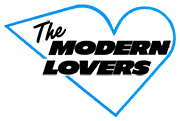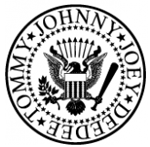The Modern Lovers: Roadrunner (1976)
 Here’s the strangest of the most influential songs in Rock music. Roadrunner* is not about sex, drugs, love or the struggles of teenage life. It’s a song of wonder and amazement. It’s about the joy of living in the moment, about radio, driving at night, Massachusetts… Here’s how writer Laura Barton, who went on a pilgrimage in all the places mentioned in (the various versions of) the song, and wrote about it on the Guardian, describes it: “Roadrunner is one of the most magical songs in existence. It is a song about what it means to be young, and behind the wheel of an automobile, with the radio on and the night and the highway stretched out before you. It is a paean to the modern world, to the urban landscape, to the Plymouth Roadrunner car, to roadside restaurants, neon lights, suburbia, the highway, the darkness, pine trees and supermarkets.”
Here’s the strangest of the most influential songs in Rock music. Roadrunner* is not about sex, drugs, love or the struggles of teenage life. It’s a song of wonder and amazement. It’s about the joy of living in the moment, about radio, driving at night, Massachusetts… Here’s how writer Laura Barton, who went on a pilgrimage in all the places mentioned in (the various versions of) the song, and wrote about it on the Guardian, describes it: “Roadrunner is one of the most magical songs in existence. It is a song about what it means to be young, and behind the wheel of an automobile, with the radio on and the night and the highway stretched out before you. It is a paean to the modern world, to the urban landscape, to the Plymouth Roadrunner car, to roadside restaurants, neon lights, suburbia, the highway, the darkness, pine trees and supermarkets.”
Jonathan Richman wrote it at nineteen, in 1970, clearly under the influence of the Velvet Underground (whom he had seen perform live many times). He recorded it first in ’72 with The Modern Lovers: drummer David Robinson (who later founded the The Cars), bass player Ernie Brooks, Jerry Harrison (later member of New Wave band Talking Heads) on keyboards, and Richman on guitar and vocals. The sessions were produced by John Cale of the Velvet Underground, whose production credits include some fine LPs of the 70s and 80s. But the self titled Modern Lovers album only came out in 1976, to critical and (relatively) commercial success. Roadrunner immediately became a cult song, and even “Johnny Rotten has said that although he hates all music, Roadrunner is his favorite song.” (The Sex Pistols covered it on their 1979 album The Great Rock’n’Roll Swindle.)
There are a million versions of this easy, two chords plus one song (D, A and a couple of Es), including Joan Jett’s in 1986♾. But most of them are by Richman himself, with some incarnation of the band (whatever outfit is playing with Richman, who is still active, is billed as The Modern Lovers). Condensed from Wikipedia:
“This version (the one featured here) was recorded in 1972 and first released as a single and in 1976. Later in 1972, the group recorded two more versions, which were released in 1981 on the album The Original Modern Lovers. A live version from 1973 was officially released in 1992. The most commercially successful version of the song, credited to Richman as a solo artist, was recorded in late 1974 and released as a single in 1975. In the UK it was released in 1977 as a single known as Roadrunner (Once)☊ and credited to Jonathan Richman, with the Cale-produced Roadrunner (Twice) (the one featured here) on the B-side, credited to the Modern Lovers. This single reached number 11 in the UK singles chart in August 1977. Also in 1977, a live 8′ 30″ version titled Roadrunner (Thrice)☊ was released. The differences are in the lyrics, the duration, the instrumentation (electric garage rock vs. acoustic rock) and the way Jonathan sings them.”
The hypnotic quality of the music (one of the best examples of Proto-Punk) shouldn’t distract you from the lyrics: this is amazing R’n’r poetry you can only write when you’re nineteen.
buy from amazon • buy from itunes • play on spotify
* This song was also mentioned as a runner up in the Songs about Power MOSS issue.
The Beach Boys: That’s Why God Made the Radio (2012)
I get a strange feeling listening to this song. Because it’s a Beach Boys song about what it was like to listen to the Beach Boys on the radio, back in the 60s. This tune had a very difficult task: to be the first Beach Boys single in 20 years. This is a band who has been incredibly successful (and hugely influential) in the mid 1960s, but that it hasn’t managed to innovate its sound (for understandable reasons: watch the 2015 Brian Wilson biopic Love & Mercy and you’ll see how the band crumbled apart). It’s pretty likely that their audience is probably the same – 50 years later. So the surviving “boys” did what they knew how to do best, and produced this little piece of nostalgia:
“Brian and I were talking about radio and how great songs used to sound through the AM radio coming through your oval speaker on your Plymouth Valiant and I said, “Man, that was the best sound of all,” and Brian said, “Yeah, that’s why God made the radio.” Of course, I wrote that down. He didn’t realize how brilliant it was, or maybe he did, but that’s when we wrote that song.” (co-author Jim Peterik, from Wikipedia)
The lyrics refer to “Making this night a celebration, spreading the love and sunshine to a whole new generation”. But I’m afraid this song (which Rolling Stone named the 30th best song of 2012) managed to reach the same people who felt the Good Vibrations of the band 46 years before – despite the cringey cross-generational embrace towards the end of the (rather corny) clip.
buy from amazon • buy from itunes • play on spotify
The Ramones: We Want the Airwaves (1981)
 This song contains an important message for all musicians, singers and songwriters (I would also add record company executives, but fortunately they seem to be extinct): this is what happens when you try to make your music more commercial. “While the band members wanted Steve Lillywhite to produce (the album Pleasant Dreams), Sire records chose Graham Gouldman in an attempt to gain popularity.” Did it work? “The album was not commercially acclaimed, which came as a surprise to Sire since they had insisted the band record with Gouldman in an effort to increase fan-base. The album was not critically acclaimed either, as it received several mixed articles by reviewers, who insisted the album to be less playable than their first four albums.” After this LP, which sounds rather mollified, The Ramones stuck to their (fantastic) original sound – again, one of the earliest incarnations of Punk Rock.
This song contains an important message for all musicians, singers and songwriters (I would also add record company executives, but fortunately they seem to be extinct): this is what happens when you try to make your music more commercial. “While the band members wanted Steve Lillywhite to produce (the album Pleasant Dreams), Sire records chose Graham Gouldman in an attempt to gain popularity.” Did it work? “The album was not commercially acclaimed, which came as a surprise to Sire since they had insisted the band record with Gouldman in an effort to increase fan-base. The album was not critically acclaimed either, as it received several mixed articles by reviewers, who insisted the album to be less playable than their first four albums.” After this LP, which sounds rather mollified, The Ramones stuck to their (fantastic) original sound – again, one of the earliest incarnations of Punk Rock.
We Want the Airwaves is about keeping Rock music on the Radio, at a time when american stations were becoming more and more commercial. This has been a recurring problem that affected many musical styles, from Rock’n’roll to Hip hop, first with the Radio and then with Tv. Luckily, today we have the Internet, but large, corporate music media (Mtv, Clear Channel, Sirius XM in USA, etc.) still operate with the same rules, and if your music is too bizarre (too fast, too slow, too political, too noisy, too simple, too complicated, too unusual, too new, too old, etc.), they’re just not gonna play it (and probably Rolling Stone isn’t going to review it: they’re too busy celebrating the return of The Beach Boys). But then again: my friend (and former student) Enrico Sangiuliano was repeatedly at #1 in the Techno chart on Beatport (where much of the interesting new dance music makes some money), is playing gigs all over the world, and I don’t think they’ve heard his music at Rolling Stone either. So, in an abstract way, we still want the airwaves. But in reality, we got them.
buy from amazon • buy from itunes • play on spotify
Runner ups
The Clash: This Is Radio Clash (1981) Here’s a radio that the Ramones would have been on.
Steely Dan: FM (No Static At All) (1978) Steely Dan‘s ode to modern, FM broadcasting.
Patti Smith: Radio Ethiopia (1976) Ten fabulous minutes of poetry, music and noise.
Kraftwerk: Radio-Aktivität (1975) The german pioneers of electronic Pop dedicated a whole album to Radio, with tracks such as Antenne, Transistor and Radioland.
There’s also a Guardian readers playlist of radio themed songs, as well as a dedicated Wikipedia page.
Well, there’s a message up in China That they’re getting in Japan It’s bouncing off an ocean liner And make ’em shake ’em in Siam
And all my kids are complaining you didnt mention the XTC’ s Radios in Motion
( tags: punk, roba suonata bene, it s never speed enough )
Oh yes – and there’s also Queen’s Radio Ga Ga.